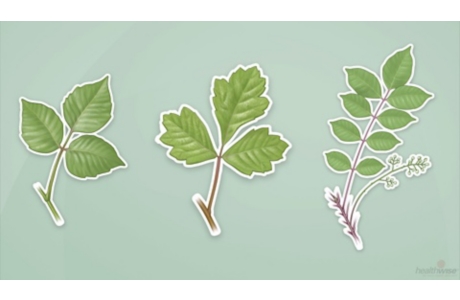Poison Ivy, Oak, or Sumac
Condition Basics
What are poison ivy, oak, and sumac?
Poison ivy, oak, and sumac are plants that can cause a red, itchy rash called allergic contact dermatitis. It is the most common skin problem caused by contact with plants.
What causes the rash?
The rash is caused by contact with a sticky oil called urushiol (say "yoo-ROO-shee-all") found in poison ivy, oak, or sumac. You can get the rash from:
- Touching or brushing against any part of these plants (including the leaves, stems, flowers, berries, or roots), even if the plant is dead.
- Touching anything that's come in contact with these plants, like clothing, sporting gear, gardening tools, or pet fur.
- Exposure to smoke from burning these plants. Urushiol attaches to smoke particles and can cause a rash on any part of the body.
The rash is an allergic reaction to the oil. You become allergic through contact. After you've come in contact with these plants, your immune system may start to react to the oil as though it's a harmful substance.
The rash is only spread through the oil. You can't catch a rash by touching the blister fluid.
What are the symptoms?
The usual symptoms are:
- Itching.
- Red streaks or general redness where the plant touched the skin.
- Small bumps or larger raised areas (hives).
- Blisters that may leak fluid.
In people who are very allergic to the oil, even a little may cause serious symptoms that need medical attention right away, such as:
- Trouble breathing.
- Swelling of the face, mouth, neck, or genitals. The eyelids may swell shut.
- Widespread, large blisters that ooze a lot of fluid.
The rash usually takes more than a week to show up the first time you have a reaction to the oil. It develops in a day or two on later contacts. The rash may form in new areas over several days, but you will only get a rash where the oil touched your skin.
The rash usually lasts about 10 days to 3 weeks. But it may last up to 6 weeks in more severe cases.
How is the rash diagnosed?
A doctor can usually diagnose the rash by looking at it. The doctor will ask when you were exposed to the plant and how long it took the rash to develop. You'll also be asked about your outdoor activities, work, and hobbies and about other rashes you've had.
How is a poison ivy, oak, or sumac rash treated?
Mild to moderate rash
If you get a mild rash, you can take care of it at home. Here are some tips to help with itching:
- Apply a cool, wet cloth for 15 to 30 minutes several times a day.
- Take short, cool baths.
- Use calamine lotion to help relieve itching.
- Try not to scratch the rash. Scratching could cause a skin infection.
If itching affects your sleep, ask your doctor if you can take an antihistamine that might reduce itching and make you sleepy, such as diphenhydramine (Benadryl). Be safe with medicines. Read and follow all instructions on the label.
Severe rash
See your doctor if:
- The rash covers a large area of your body.
- Your symptoms are severe.
Your doctor may treat your rash with prescription corticosteroid pills, creams, or shots.
How can you prevent the rash?
If you think you have touched any of these plants:
- Wash your skin right away with plenty of water. If you can, use liquid dish soap or a mild soap and very warm running water.
- Use a brush to clean under your nails.
- Wash any clothing or other items that might have the oil on them. Do it right away.
The best way to prevent future rashes is to learn to identify these plants and avoid them.
When you can't avoid contact with the plants:
- Wear long pants, long sleeves, and closed shoes to help keep the oil from getting on your skin.
- Wear vinyl or leather gloves. Rubber (latex), cotton, or wool gloves offer no protection.
- Use a barrier cream or lotion, such as Ivy X Pre-Contact Skin Solution. It can help keep the oil from coming in contact with your skin.
- If you did not use a preventive product and you have had contact with plant oil, clean it off your skin with an after-contact product as soon as possible. These products, such as Tecnu Original Outdoor Skin Cleanser, can also be used to clean plant oil from clothing or tools.
Experts say not to burn plants like poison ivy, oak, or sumac. When these plants burn, urushiol attaches to smoke particles. Exposure to the smoke can cause a rash on your skin. Breathing in the smoke can also hurt your lungs.
Credits
Current as of: November 16, 2023
Author: Ignite Healthwise, LLC Staff
Clinical Review Board
All Healthwise education is reviewed by a team that includes physicians, nurses, advanced practitioners, registered dieticians, and other healthcare professionals.
Current as of: November 16, 2023
Author: Ignite Healthwise, LLC Staff
Clinical Review Board
All Healthwise education is reviewed by a team that includes physicians, nurses, advanced practitioners, registered dieticians, and other healthcare professionals.




